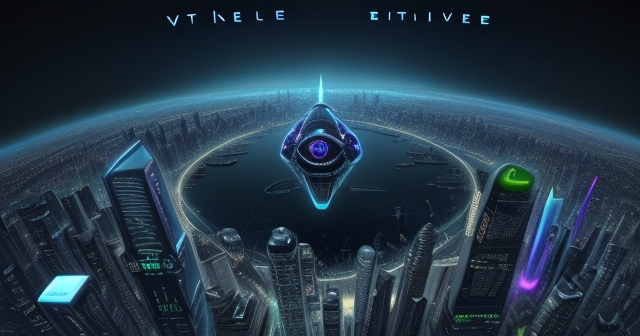Investing in the Metaverse: Navigating the Next Frontier of Digital Interaction
Imagine stepping into a persistent, interconnected digital universe, a space where work, social interaction, entertainment, and commerce seamlessly blend. This isn’t just science fiction anymore; it’s the vision driving the concept of the Metaverse. While still in its foundational stages, the metaverse represents a potentially massive future market, attracting significant investment and technological innovation. As investors, you might be asking, how can we participate in this emerging trend? What are the key opportunities? This article will guide you through understanding the metaverse ecosystem and exploring the companies poised to be the builders and enablers of this next digital frontier – the so-called metaverse stocks.
We’ll break down the complex layers that make up this nascent digital world, identify some of the significant players based on their contributions to these layers, and discuss how you might approach investing in this exciting, albeit speculative, area. Think of us as your guide exploring a new digital city under construction. There’s dust and scaffolding now, but the potential is enormous. Are you ready to explore the building blocks?

Just like building a physical city requires infrastructure, buildings, and services, the metaverse needs a robust ecosystem of technologies to exist. Understanding these layers is crucial for identifying potential investment opportunities. We can think of the metaverse as being built upon several key components:
- Infrastructure: This is the bedrock – high-speed connectivity (5G, fiber), cloud computing, and powerful processing capabilities. Without robust internet and data centers, the seamless, real-time interaction required by the metaverse is impossible.
- Computing: The engine room. This includes the companies designing and manufacturing the chips (like semiconductors and GPUs) necessary for rendering complex 3D graphics, running sophisticated simulations, and processing vast amounts of data in real-time.
- Hardware: The access points. These are the devices you’ll use to enter and interact with the metaverse, primarily Virtual Reality (VR) and Augmented Reality (AR) headsets, but also potentially specialized computers and mobile devices capable of handling immersive environments.
- Software and Tools: The building materials and design kits. This includes the 3D content creation platforms, game engines, development kits, and simulation software that developers use to build digital worlds, assets, and experiences.
- Platforms and Worlds: The destinations themselves. These are the specific virtual environments, games, and social spaces where users will gather, interact, and transact. Think of existing platforms like Roblox or developing virtual world initiatives.
- Exchange and Payments: The economy. This layer involves digital currencies, blockchain technology for digital ownership (NFTs), payment processing systems, and financial services enabling transactions within the metaverse.
- Services and Solutions: The enablers. Companies providing professional services, AI integration, cybersecurity, data management, and other specialized solutions needed to develop, manage, and secure metaverse environments and experiences for businesses and individuals.
Investing in the metaverse isn’t just about buying stock in one virtual world platform. It’s about identifying companies contributing significantly to one or more of these fundamental layers. Many established tech companies are already key players across multiple layers.

How will you step into the metaverse? The primary answer currently lies in increasingly sophisticated hardware and the platforms designed for user interaction. These companies are building the interfaces and the initial destinations.
One of the most prominent names heavily investing in this space is Meta Platforms (META), formerly Facebook. Through their Reality Labs division, Meta is pouring billions into developing VR and AR hardware, most notably the Oculus (now Meta Quest) line of headsets. They envision a future where these devices are commonplace tools for social connection, work, and entertainment in their evolving digital spaces. Their commitment is undeniable, making them a central, albeit risky, bet on the metaverse’s eventual widespread adoption.
While often not using the term “metaverse” explicitly, Apple (AAPL) is positioning itself firmly in the immersive hardware space with its focus on “spatial computing” and the development of its high-end AR/VR headset, the Vision Pro. Apple’s entry could legitimize and accelerate adoption of immersive technology, leveraging its vast ecosystem and user base. While their strategy may differ from Meta’s, their hardware ambitions are clearly aligned with providing a powerful gateway to future digital interactions.
Looking at existing platforms, Roblox (RBLX) is frequently cited as an early model of a metaverse destination. It’s a massive online platform where users can create and play games developed by other users. While perhaps less graphically advanced than future visions, Roblox has a large, active user base and a functioning creator economy, demonstrating key aspects of what a successful metaverse platform might look like. Their strength lies in their community and established ecosystem of creators and players.
These companies represent different approaches to the access layer – one focused on accessible hardware and a broad vision (Meta), another on premium hardware and a new computing paradigm (Apple), and a third on an existing, successful user-generated content platform (Roblox). Each plays a vital role in bringing the metaverse from concept to tangible experience.

Beneath the user interfaces and virtual spaces lies the critical infrastructure and the tools that allow the metaverse to be built and to function smoothly. This is where immense computing power and sophisticated software come into play.
When we talk about rendering complex 3D environments in real-time for potentially millions of users, we are talking about a massive need for processing power. This is where NVIDIA (NVDA) stands out as a cornerstone metaverse stock. NVIDIA is the leading designer of GPUs (Graphics Processing Units), which are essential for powering high-fidelity graphics in games, simulations, and virtual worlds. Furthermore, NVIDIA is developing its Omniverse platform, described as a platform for connecting 3D worlds into a shared virtual universe. Omniverse is designed for simulation, collaboration, and creating digital twins, technologies highly relevant to industrial and enterprise applications within the metaverse. NVIDIA provides both the fundamental hardware muscle and the software tools necessary for building and connecting digital environments.
Creating the digital content and environments within the metaverse requires specialized tools. Unity Software (U) is a leader in this space. Unity provides a popular 3D development platform used by creators worldwide to build games, simulations, and other interactive experiences. Their software is essential for building the assets, characters, and environments that populate virtual worlds. As the metaverse grows, the demand for skilled 3D content creators will explode, and platforms like Unity will be the fundamental tools they rely on. Think of them as providing the hammers, saws, and blueprints for the digital construction workers.
Beyond GPUs and 3D engines, the metaverse relies on powerful semiconductors across the board, high-speed networking equipment, and robust cloud infrastructure. While we highlighted NVIDIA and Unity for their direct metaverse-specific contributions, other companies in the broader semiconductor, networking, and cloud sectors also form vital parts of this technological foundation.
These companies, therefore, offer exposure to the fundamental technological advancements that the metaverse requires, focusing on the processing power and the content creation capabilities that make immersive digital worlds possible.

Building and integrating metaverse technologies isn’t just about creating consumer hardware or platforms. Businesses, industries, and organizations will need help navigating this new landscape, integrating digital twins into operations, creating virtual training environments, or developing new customer engagement models. This creates a significant opportunity for companies providing professional services and digital solutions.
Accenture (ACN) is a global professional services company with extensive capabilities in strategy, consulting, technology, and operations. Accenture has explicitly identified the metaverse as a key area of focus, offering services to help businesses understand, strategize for, and implement metaverse-related solutions. They assist companies in everything from building virtual experiences and digital twins to integrating blockchain for digital assets and advising on metaverse strategy. Their broad expertise and global reach position them to capitalize on enterprise and industry adoption of metaverse technologies.
Similarly, Globant (GLOB) provides digital transformation services, specializing in areas like software development, AI, blockchain, and cloud technologies. Globant works with companies to build innovative digital products and experiences. They also have specific offerings related to the metaverse, focusing on creating immersive user experiences, developing digital assets, and building the underlying technology platforms. As the metaverse matures, the need for skilled developers and consultants who can build and integrate complex digital solutions will grow exponentially, making companies like Accenture and Globant key enablers on the service side.
Investing in these companies offers a different kind of exposure to the metaverse. Instead of betting on the success of a single hardware device or platform, you are investing in the companies that will help businesses and organizations utilize and build within the metaverse, regardless of which specific platform or hardware becomes dominant. They are the consultants and builders helping others navigate this new space.

While much of the metaverse discussion centers around major US tech giants, the development and adoption of immersive digital worlds are inherently global. Companies from around the world are contributing to this ecosystem from various angles.
In South Korea, a leader in connectivity and gaming, companies like SK Telecom (SKM) are exploring the metaverse from a telecommunications perspective. As a major mobile operator, SK Telecom is developing its own metaverse platform, “Ifland,” focusing on social interaction and virtual events. This highlights the role of telcos in providing the necessary network infrastructure and potentially creating their own digital destinations, particularly in markets with high mobile penetration and tech-savvy populations.
Chinese companies are also significant players, although accessing them directly can be complex for many international investors. The data points to companies like Xiao-I (AIXI), which focuses on conversational AI platforms and hyperautomation. While not solely metaverse-focused, sophisticated AI and natural language processing will be crucial for creating interactive and intelligent agents and experiences within the metaverse. Imagine interacting with realistic AI characters or automated services in a virtual world – companies like Xiao-I could provide the underlying technology.
Other companies mentioned, such as NIP Group (NIPG), an esports organization, or Future FinTech Group (FTFT), involved in various digital businesses including cryptocurrency mining and fintech services, show the diverse potential applications and infrastructure pieces related to the metaverse. Esports and virtual events are already close cousins of metaverse experiences, while fintech and crypto could underpin the digital economies that emerge within these worlds.
Looking beyond the well-known names reveals that the metaverse is a global phenomenon, with contributions coming from various sectors and regions. This underscores the complexity and interconnectedness of the ecosystem and offers opportunities for international diversification for investors.
Based on our breakdown of the ecosystem and the players involved, we can consolidate a list of companies frequently cited as key metaverse stocks to watch. Remember, this list is not exhaustive and the market is constantly evolving.
| Company | Description |
|---|---|
| NVIDIA (NVDA) | A foundational player in computing and graphics, essential for rendering virtual worlds. Provides both hardware (GPUs) and software (Omniverse). |
| Accenture (ACN) | A leading professional services firm guiding businesses on metaverse strategy and implementation. |
| Globant (GLOB) | A digital transformation company offering development and consulting services for building metaverse solutions. |
| Meta Platforms (META) | A major direct investor focusing on consumer hardware (VR/AR headsets) and building its own metaverse vision. |
| Roblox (RBLX) | Operates a popular user-generated content platform considered an early example of a metaverse destination with a strong community and economy. |
| Apple (AAPL) | Focused on high-end AR/VR hardware (“spatial computing”) and positioning itself as a key hardware gateway to future immersive experiences. |
| Unity Software (U) | Provides essential 3D content creation software used by developers to build games and interactive metaverse experiences. |
| SK Telecom (SKM) | A South Korean telecom provider developing its own metaverse platform, highlighting the role of connectivity and regional platforms. |
| Xiao-I (AIXI) | Focused on AI technologies (like conversational AI) that will be crucial for realistic interactions within the metaverse. |
| NIP Group (NIPG) | An esports organization, relevant due to the close ties between gaming, virtual events, and the metaverse. |
| Future FinTech Group (FTFT) | Involved in digital businesses including cryptocurrency mining and fintech, potentially supporting digital economies and transactions in the metaverse. |
Each of these companies offers exposure to the metaverse trend, but through different lenses. Some provide the foundational technology, others build the platforms or content, and some offer the services needed to integrate the metaverse into existing industries. Understanding their specific role helps clarify the type of exposure you are getting.
Once you’ve identified potential metaverse stocks, the next step is to perform financial analysis. While the metaverse is a long-term thematic investment, traditional financial metrics provide insights into a company’s current health, valuation, and market sentiment. What should you look at?
| Metric | Description |
|---|---|
| Market Capitalization | This tells you the total market value of the company. Large-cap companies like NVIDIA (NVDA) and Accenture (ACN) offer stability but potentially slower growth compared to smaller-cap players. |
| Price-to-Earnings (P/E) Ratio | This compares the stock price to the company’s earnings per share. A high P/E ratio suggests the market has high expectations for future growth. |
| PEG Ratio | This metric refines the P/E ratio by factoring in the company’s expected earnings growth rate. A PEG ratio near 1 suggests the stock is fairly valued relative to its growth potential. |
| Beta | This measures a stock’s volatility compared to the overall market. A beta greater than 1 means the stock is typically more volatile than the market. |
| Financial Ratios | Looking at ratios like the Current Ratio and Quick Ratio can tell you about a company’s short-term liquidity. |
| Moving Averages | Technical analysis tools like the 50-day and 200-day moving averages can help identify trends in the stock price. |
| Trading Volume | High trading volume generally indicates strong investor interest and liquidity, making it easier to buy or sell shares. |
Analyzing these metrics provides a snapshot, but it’s crucial to look at trends over time and compare companies within the same sector. For example, comparing the valuation metrics of NVIDIA, Accenture, and Globant reveals different risk/reward profiles based on their size, growth rate, and business model.
Keep in mind that for emerging technologies like the metaverse, many companies might be investing heavily (depressing current earnings) in anticipation of future revenue, which can distort traditional metrics like P/E. It’s essential to look beyond just the numbers and understand the company’s strategic vision and execution ability within the metaverse context.
Investing in individual metaverse stocks can be exciting but also carries significant risk, especially given the early stage of the market. A single company might fail to execute its vision, or its specific technology might not become the industry standard. For many investors, particularly those new to this theme, diversification is key.
One straightforward way to gain diversified exposure to the metaverse trend is through Metaverse Exchange-Traded Funds (ETFs). These funds hold a basket of stocks of companies involved in various aspects of the metaverse ecosystem. Examples include the Roundhill Ball Metaverse ETF (METV) and the ProShares Metaverse ETF (VERS). Investing in a metaverse ETF allows you to spread your risk across multiple companies involved in different layers of the ecosystem – from hardware and software to platforms and services – without having to research and select each stock individually. You own a small piece of many metaverse-related companies.
When considering an ETF, pay attention to its holdings (which companies it includes), its expense ratio (the annual fee charged as a percentage of your investment), and its historical performance (though past performance is not indicative of future results). ETFs offer liquidity and relative ease of trading, similar to individual stocks.
Beyond stocks and ETFs, some investors also consider cryptocurrencies that might play a role in the metaverse, particularly those related to blockchain technology, decentralized platforms, or digital economies. Cryptocurrencies like Theta (THETA), focused on decentralized video delivery, or Internet Computer (ICP), aiming to create a decentralized internet, are sometimes mentioned in the context of providing infrastructure for decentralized metaverse elements. However, it’s vital to understand that cryptocurrencies are a distinct asset class with different risks and volatility profiles than stocks. Their connection to the metaverse vision is often more speculative and focused on potential future infrastructure rather than current revenue streams from metaverse activities. We should view them as an adjacent, higher-risk area compared to investing in established companies building the core tech and services.

Diversifying through ETFs or by exploring adjacent asset classes like relevant cryptocurrencies can help mitigate the specific risks associated with picking individual winners in a developing market. However, remember that even a diversified metaverse investment carries the inherent risk associated with the theme itself – that the metaverse vision may take longer to materialize or evolve differently than currently expected.
So, you’ve identified potential metaverse stocks and ETFs, and you understand the different ways to gain exposure. How do you put this into practice? You’ll need the right tools and a careful approach.
First, you’ll need a brokerage account to buy and sell stocks and ETFs. Many online brokerage platforms are available, offering varying fee structures, research tools, and access to different markets.
To help you research specific companies and compare potential investments, stock screeners are invaluable tools. Platforms like MarketBeat or TipRanks (which provides data like analyst ratings, Smart Scores, and insider trading information) offer screeners that allow you to filter stocks based on criteria like market capitalization, industry sector (though “metaverse” might be a theme, not a strict sector), financial metrics (P/E, Beta, etc.), and even technical indicators (moving averages). Using a screener can help you narrow down the universe of thousands of stocks to a more manageable list of potential metaverse plays that fit your investment criteria.
Remember that fundamental analysis (looking at a company’s business, financials, and market position) and technical analysis (looking at price charts and trading volume) are both important. For a long-term thematic investment like the metaverse, understanding the company’s role in the ecosystem and its potential for future growth is paramount, but financial health and valuation metrics provide necessary context.
Crucially, consider your own risk tolerance and investment horizon. The metaverse is a long-term trend, likely requiring patience over years, perhaps even a decade or more, for the vision to fully materialize and for companies to generate significant, sustained revenue from metaverse activities. This is not a short-term trade. Be prepared for volatility and potential setbacks as the technology develops and market adoption evolves.
Many investors find success using strategies like Dollar Cost Averaging, where you invest a fixed amount at regular intervals regardless of the stock price. This can help reduce the risk of investing a lump sum just before a market downturn and averages out your purchase price over time. Given the volatility of tech and growth stocks, this can be a sensible approach.
While the potential of the metaverse is vast and compelling, it’s crucial to maintain a realistic perspective. The metaverse is still in its early stages, and significant challenges lie ahead. Recognizing these challenges is part of adopting an EEAT-compliant (Experienced, Expert, Authoritative, Trustworthy) approach to investing.
One major challenge is interoperability. For a true metaverse to exist, different platforms and digital worlds need to be able to communicate and allow users and assets to move seamlessly between them. Achieving this level of standardization and collaboration among competing tech giants is a massive undertaking.
Another hurdle is widespread adoption. While gaming platforms have millions of users, the vision of the metaverse as a place for work, education, and everyday social interaction requires mass market appeal and accessible, comfortable hardware. The current generation of VR/AR headsets can be expensive, bulky, or cause discomfort for some users. Technology needs to improve significantly to reach mainstream adoption levels comparable to smartphones.
Regulatory and ethical considerations are also critical. Issues around data privacy, online safety, digital identity, content moderation, and potential monopolies need to be addressed as these digital worlds develop. Different countries may adopt different regulatory approaches, adding complexity.
Furthermore, the energy requirements for powering massive, persistent, real-time 3D environments and potentially blockchain-based economies are substantial. Addressing the sustainability of the metaverse’s underlying infrastructure will be increasingly important.
Despite these challenges, the trajectory of technological advancement in areas like computing power, graphics rendering, AI, and network speed suggests that the technical building blocks are rapidly improving. Major corporations are investing heavily, signaling a belief in the long-term viability of the concept, even if the timeline and final form of the metaverse remain uncertain.
As investors, this means expecting a potentially bumpy road. There will likely be hype cycles, periods of rapid progress followed by plateaus, and shifts in which companies or technologies seem most promising. Maintaining a long-term perspective, focusing on the fundamental value and role of the companies you invest in, and staying informed about technological and market developments will be essential.
top metaverse stocksFAQ
Q:What are metaverse stocks?
A:Metaverse stocks refer to shares of companies that are involved in creating and building metaverse technologies, platforms, or services.
Q:How can I invest in the metaverse?
A:You can invest in the metaverse through buying shares of companies involved in hardware, software, and services, as well as through exchange-traded funds (ETFs) focused on the sector.
Q:Are metaverse investments risky?
A:Yes, investing in the metaverse can be risky due to its nascent nature, technological uncertainty, and potential market volatility.
The metaverse represents a potential evolution of the internet, moving towards more immersive, interactive, and integrated digital experiences. Investing in metaverse stocks offers a way to participate in this exciting long-term trend, but it requires careful consideration and a clear understanding of the ecosystem.
We’ve seen that the metaverse isn’t a single entity but a complex environment built upon layers of technology: the infrastructure that powers it, the hardware you use to access it, the software tools that build its content, the platforms that serve as destinations, and the services that help integrate it into businesses and daily life. Key companies like NVIDIA, Accenture, Globant, Meta Platforms, Roblox, Apple, and Unity Software, among others globally, are playing significant roles in building these layers.
Approaching this market requires more than just identifying names; it demands understanding their specific contributions, analyzing their financial health and valuation using metrics and considering how they fit into your overall investment strategy and risk tolerance. Diversification, perhaps through Metaverse ETFs, can be a prudent strategy to mitigate the risks associated with investing in a developing theme.
While the metaverse vision is compelling, remember it is still nascent and faces significant technological, social, and regulatory hurdles. Investing in this space is a long-term proposition that requires patience and a willingness to navigate volatility. By focusing on the fundamental building blocks and the companies providing essential technologies and services, you can position yourself to potentially benefit from the growth of this next digital frontier.
Armed with knowledge about the ecosystem, the key players, and the tools for analysis, you are better equipped to explore the world of metaverse stocks. Like venturing into any new territory, preparation and a thoughtful approach are your best companions.

留言